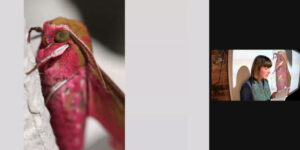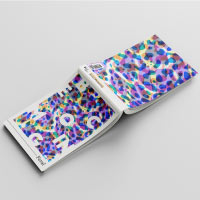
Explore the complex relationships between humans and other-animals through becoming–Feral, a collection of poetry, visual art, essays, and more—all focused on understanding the shifting categories of ‘feral’ and ‘domestic’ within a landscape that is being altered by global transformations of climate and capitalism. Co-edited by Nelson Institute and School of Education doctoral candidate Alexandra Lakind, the book, which was released on November 10, features the work of over 80 contributors from a variety of genres and disciplines. To showcase multimedia contributions the book release also included a digital companion collection available on the becoming–Feral website.
As the book release coincided with the United Nations Climate Change Conference (COP26) taking place in Glasgow, Scotland October 31 through November 12 the becoming–Feral book launch included an online and in-person public event that featured presentations from a number of becoming–Feral contributors.
“I think the launch was a wonderful moment,” said Lakind. “Firstly, it was amazing to see so many of the contributors gathered together. We are so lucky to have found so many supportive and inspiring people eager to engage with this project. Secondly, it was also very exciting to see how many people joined the in-person Glasgow-based event virtually from around the world. I was happy to be able to have an intimate and COVID-considerate in-person launch that invited in dozens more people from all over. From the Netherlands to Russia to South Australia we had people celebrating across landscapes, time zones, and seasons”.
The creation of becoming–Feral was made possible in part through support from the Nelson Institute Center for Culture, History, and Environment (CHE). The CHE Research Initiative provides sponsorship of working groups engaged in transdisciplinary collaborations that examine human dimensions of environmental issues. In spring 2021, the multidisciplinary and multi-institutional CHE working group, “Feral Worlds,” collected submissions for the becoming–Feral publication. Becoming–Feral is the second book in a series called “BECOMING,” which includes creative research publications that investigate the diverse reciprocal relationships between humans and Others. What resulted from the becoming–Feral call for submissions was over a hundred contributions from across the globe—from India to Argentina. These submissions span a variety of mediums and topics, from atomic bees to viral rabbits. Once submissions were gathered, the Feral Worlds working group began the editorial process of creatively forming contributions into a cohesive and vibrant display of feral meanings.

“What the Feral Worlds CHE working group has done with the creation of becoming–Feral is nothing short of astonishing,” said CHE assistant director, Rachel Gurney. “The becoming–Feral book is just one example of what can emerge when scholars, scientists, artists, and others are provided support for collaboration. CHE is a proud supporter of such endeavors and the collaborative work of our Associates broadly.”
The Feral Worlds working group was led by Nelson Institute and School of Education doctoral candidate, Alexandra Lakind, and included UW-Madison graduate students Addie Hopes, Emery Jenson, and Sabrina Manero, as well as Josh Armstrong (Royal Conservatoire of Scotland), Chessa Adsit-Morris (University of California, Santa Cruz), and Rebekka Sæter (Independent Artist). The Feral Worlds working group approached the editorial process from divergent perspectives and interests, which led to the creation of a publication that embodies a diversity of styles and expressions.
“Through a diverse range of entries, we have compiled a ‘book of beasts’ that shifts our attention from the panic of ever-coming catastrophe towards a strategy for living and dying on a planet in need of maintenance and repair,” shared Lakind.
In addition to CHE’s support of the creation of becoming–Feral, the Royal Conservatoire of Scotland offered support through their Research & Knowledge Exchange program, which—along with the CHE—helped fund the first book in the BECOMING series, becoming–Botanical. This additional funding enabled Objet-a Creative Studio—a charitable arts organization based in Glasgow, Scotland—to oversee the production and publication of becoming-Feral, under the artistic direction Josh Armstrong.
“I was very pleased to be able to work with the Center for Culture, History, and Environment,” said Objet-a Creative Studio artistic director and lecturer with the Royal Conservatoire Scotland, Josh Armstrong. “It was really fruitful to have other voices join thanks to the formation of the Feral Worlds working group, which fostered deeper, more critical engagement with the topic, and enabled us to create robust linkages across organizations, institutions, and individuals.”
Learn more about becoming–Feral.